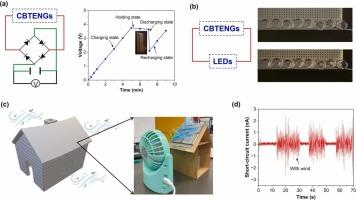通过表面功能化的高性能抗湿水泥基摩擦电纳米发电机
IF 17.1
1区 材料科学
Q1 CHEMISTRY, PHYSICAL
引用次数: 0
摘要
水泥基摩擦电纳米发电机(CBTENGs)有望在智能民用基础设施中实现可持续的能源收集。然而,在潮湿和潮湿的环境中,性能下降仍然是一个关键的挑战。本研究提出了一种结合功能性填料和表面改性的综合策略,以提高cbteng的电力输出性能和环境适应性。来自氢气生产的再生石墨碳材料被纳入水泥基质中,以优化电荷捕获和介电行为。对氧等离子体处理和化学气相沉积全氟辛基三乙基氧基硅烷(POTS)涂层两种胶凝表面技术进行了系统比较。氧等离子体处理引入极性官能团,增加亲水性并抑制输出,而POTS涂层使胶凝表面具有高度疏水性,显著提高了潮湿条件下的电荷保留率。优化后的CBTENG(含有0.5 wt.%的石墨碳和POTS涂层)实现了~480 V的峰值开路电压和~3µa的短路电流,并且可以在潮湿条件下保持75%以上的输出保留率。演示了几个实际应用,包括电容器充电、LED供电、屋顶风力能源收集以及潮湿交通条件下基于路面的能源收集。研究结果为实现耐用和高性能的cbteng提供了一种创新方法,推动了能量收集混凝土与智能和自供电基础设施系统的整合。本文章由计算机程序翻译,如有差异,请以英文原文为准。

High-performance and humidity-resilient cement-based triboelectric nanogenerators (CBTENGs) via surface functionalisation
Cement-based triboelectric nanogenerators (CBTENGs) are promising for enabling sustainable energy harvesting in intelligent civil infrastructure. However, performance degradation in humid and wet environments remains a critical challenge. This study presents a comprehensive strategy that combines functional fillers and surface modification to enhance both the electric output performance and environmental adaptability of CBTENGs. Recycled graphitic carbon materials derived from hydrogen production are incorporated into cement matrices to optimise charge-trapping and dielectric behavior. Two cementitious surface techniques – oxygen plasma treatment and perfluorooctyltriethoxysilane (POTS) coating via chemical vapor deposition – were systematically compared. While oxygen plasma treatment introduces polar functional groups that increase hydrophilicity and suppress output, POTS coatings render the cementitious surface highly hydrophobic, significantly improving charge retention in moist conditions. The optimised CBTENG (containing 0.5 wt% graphitic carbon and a POTS coating) achieves a peak open-circuit voltage of ∼480 V and a short-circuit current of ∼3 µA, and can sustain performance in wet conditions with over 75 % output retention. Several practical applications are demonstrated, including capacitor charging, LED powering, wind-driven energy harvesting from a house roof, and pavement-based energy collection under wet traffic conditions. The results provide an innovative approach to achieving durable and high-performance CBTENGs, advancing the integration of energy-harvesting concrete into smart and self-powering infrastructure systems.
求助全文
通过发布文献求助,成功后即可免费获取论文全文。
去求助
来源期刊

Nano Energy
CHEMISTRY, PHYSICAL-NANOSCIENCE & NANOTECHNOLOGY
CiteScore
30.30
自引率
7.40%
发文量
1207
审稿时长
23 days
期刊介绍:
Nano Energy is a multidisciplinary, rapid-publication forum of original peer-reviewed contributions on the science and engineering of nanomaterials and nanodevices used in all forms of energy harvesting, conversion, storage, utilization and policy. Through its mixture of articles, reviews, communications, research news, and information on key developments, Nano Energy provides a comprehensive coverage of this exciting and dynamic field which joins nanoscience and nanotechnology with energy science. The journal is relevant to all those who are interested in nanomaterials solutions to the energy problem.
Nano Energy publishes original experimental and theoretical research on all aspects of energy-related research which utilizes nanomaterials and nanotechnology. Manuscripts of four types are considered: review articles which inform readers of the latest research and advances in energy science; rapid communications which feature exciting research breakthroughs in the field; full-length articles which report comprehensive research developments; and news and opinions which comment on topical issues or express views on the developments in related fields.
 求助内容:
求助内容: 应助结果提醒方式:
应助结果提醒方式:


